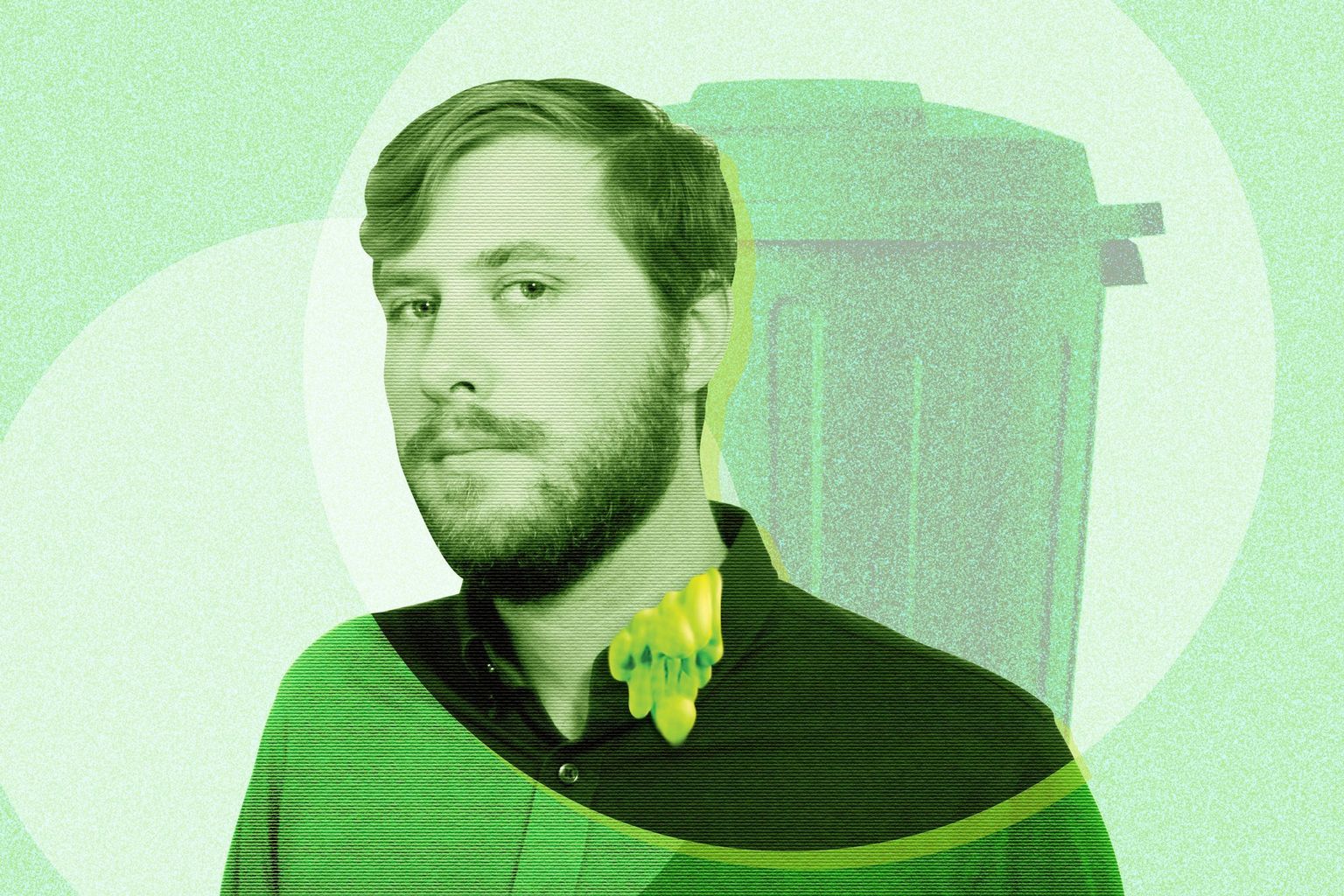
Photo illustration by Greta Larkins
If reading emails is your idea of fun, there’s arguably never been a better time to be alive. (A weird thing to say about 2024, but to each their own.) Over 17,000 writers are now earning a living on Substack, with tens of thousands more writing for free or publishing on rival platforms like beehive. There’s a lot of newsletters out there, is what we’re saying. And Garbage Day, written by journalist Ryan Broderick, is among the best—and most popular.
After spending the 2010s working the internet culture beat for publications like Vice and BuzzFeed, Broderick decided to go out on his own, launching Garbage Day in 2019. He publishes three times a week—a frankly prodigious output—covering everything from how surreal AI cooking videos are taking over the internet to how a random Malaysian Instagram user ended up creating one of the defining images of the Israel–Palestine war.
In the five years since his first issue, Broderick’s gone from media insider darling to one of the leading voices on internet culture: Garbage Day now boasts nearly 70,000 readers, around 3000 of whom are paid subscribers. Because newsletters are such a big part of our media diet, and because we here at The Story quietly live in awe of his output, we reached out to Broderick to find out how he does what he does, (garbage) day in, (garbage) day out.
This question would be an extremely boring thing to ask, say, a corporate lawyer. But you write a really fun newsletter for a living, so I think I can get away with it: What does a typical day look like for you on the tools? Any set routines or rituals?
My routine is pretty solid actually. Without one I think I'd go crazy. From around 9 am to 12 pm on Mondays, Wednesday and Fridays, I lay out what's going in the newsletter and work on the large top essay. Then at noon I take a lunch break and actually go and make lunch. I've learned that taking that 45-minute-to-an-hour break is helpful. Gives my brain some time to put connections together. Then after lunch, I finish up the rest of the newsletter and try to get it out by at least 3 pm. After that I answer emails, hang out in my Discord and just sort of wind down for the day. And right now, Tuesdays and Thursdays are my free days to do freelance work, record stuff for my podcast, and work on longer-term projects. (It's basically what my class schedule was during college lol.)
You’re putting out about 6000 words each week, on top of everything else you do. How do you plan your content? Are you just online all the time, absorbing what’s happening, or are there bigger ideas you’ve established that you try to pursue?
I use a passive planning system for the most part. I have an app called Raindrop that's synced across all my devices and I have folders in it that I add links to as I go about my day. So I have a folder for the newsletter, a folder for things I want to include in my live shows, another for podcast ideas. And whenever I see something online that, in the moment, feels like it could work with something I'm doing I save it there. So when it comes time to put together an issue of Garbage Day or program out a live show, it's all there for me already.
There’s no big publisher behind Garbage Day—it’s just you. What are some of the challenges—big or small—of running an independent newsletter?
I think they're about the same as non-indie publications. It's about trying to get your business margins bigger, trying to keep your audience (and yourself) interested, following the news, figuring out where you can jump in on something. tbh doing Garbage Day is not that different from any other newsroom job I've had. Maybe a bit slower and scrappier, but nothing philosophically different.
Without an editor to answer to, how do you keep yourself motivated to stay on track?
I don't hit, like, incapacitating writers block very often, but it happens. I now have a researcher, Adam Bumas, and having another person in the mix really helps, especially when I get stuck. But for the most part my problem has always been over-writing, not under-writing.
Most people feel like they need to spend less time on the internet. But your job obviously depends on you being chronically online—which we know isn’t good for your health. How do you avoid burning out?
I try to be firm about vacations. I take around two-to-three breaks a year. I also try to mix up the format. I experiment a lot. My theory on burnout is that it's not simply about overwork. The times I've felt the most burnt out have been due to a mixture of lack of agency—as in I do not control what I'm doing and feel alienated because of it—and a lack of progress—what I'm doing is not noticeably growing or changing in any way. So I try to account for that and set new goals regularly. It's not perfect, but it helps.
Your newsletter’s exploded in the last five years—from 2,000 media insiders to nearly 70,000 god-knows-whos. Do you think about that when you’re writing—the changing face of your audience?
I've gone through a couple huge growth phases. Currently still in one I think. It's always a weird feeling. You get a bunch of new readers and you sort of have to make the decision of either catering to the newbies or just ignoring it. I've found that long-term growth is better if you ignore it. Just do your thing and if they don't stay they weren't ever going to stay.
You went full-time with Garbage Day about a year in—what was it like to quit your job and make emails your whole thing?
It was terrifying. It was the peak of COVID lockdown. I took a risk, but I didn't have any other options really. Which probably helped. There was really nothing else I could have done so it sort of had to work haha.
Here’s one for the aspiring newsletter writers: How do you grow your subscriber base? Going from 2000 to 70,000 is bananas. Was that something you actively worked on, or did it just happen organically?
I'm less aggressive about this than I used to be, but the early growth plan was based around email forwards. Substack, where I started, had this feature that would send me a notification every time I got a new reader and I kept an eye on who was signing up. And I started to notice that people with the same domain names, of like a company or a business, would sometimes all sign up at once. That to me was a signal that I had been forwarded around or dropped in a Slack room. Digital word of mouth. And so I tried to lean into stuff that seemed to cause that kind of response. It wasn't super scientific, but I think it was a useful exercise early on. "Would someone forward this email to someone else?"
A lot of writers name-drop you as a source of inspiration. Who do you turn to for hot takes and to stay inspired?
There are a whole host of tech writers I love, Charlie Warzel, Rusty at Tabs, Taylor Lorenz, John Herrman, Rebecca Jennings, the team over at 404 Media, but tbh the world of internet culture journalism is shrinking. A lot of great writers have been laid off and that pool is a lot smaller than it used to be. So now a lot of the stuff I'm getting the most fired up about are YouTubers making videos about music or anime or other kinds of pop culture stuff. And then I try to apply what they're doing to my own patch.
What advice would you give to someone just starting their own newsletter? Any pitfalls to watch out for?
If you're based in the US, don't form an S-Corp!!! Stay an LLC for as long as you can!!!!!! This tax year almost killed me. [Ed: For our Australian readers, Bryan’s advice basically translates to staying a sole trader—though for the love of god please do not consider this as tax advice in either jurisdiction.] But more broadly the biggest mistake I see new publications make is launching with like, three or four different columns and products. "On Mondays we do this, on Tuesdays we do this, and there's a podcast, and there's a yadda yadda yadda." If you're one person, you should probably do just one thing for a while. And even as you get bigger try and keep it focused on a couple things that you know you can do consistently.
Got a newsletter creator you think should be featured in Inbox Icons? Drop us a line with your recommendation.
